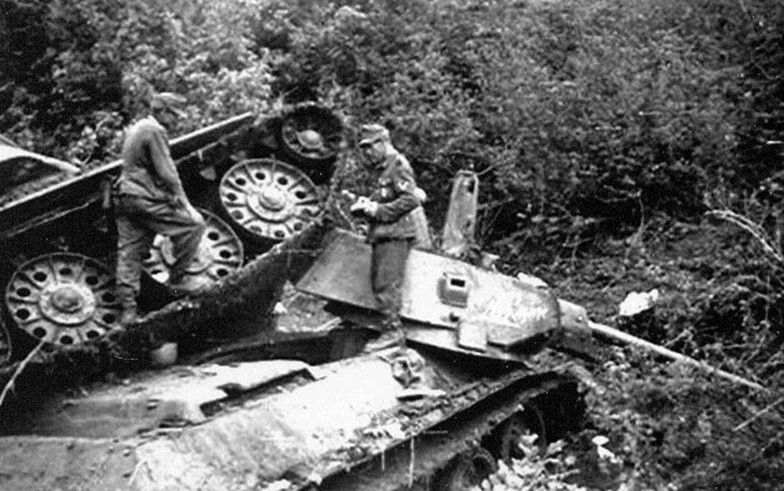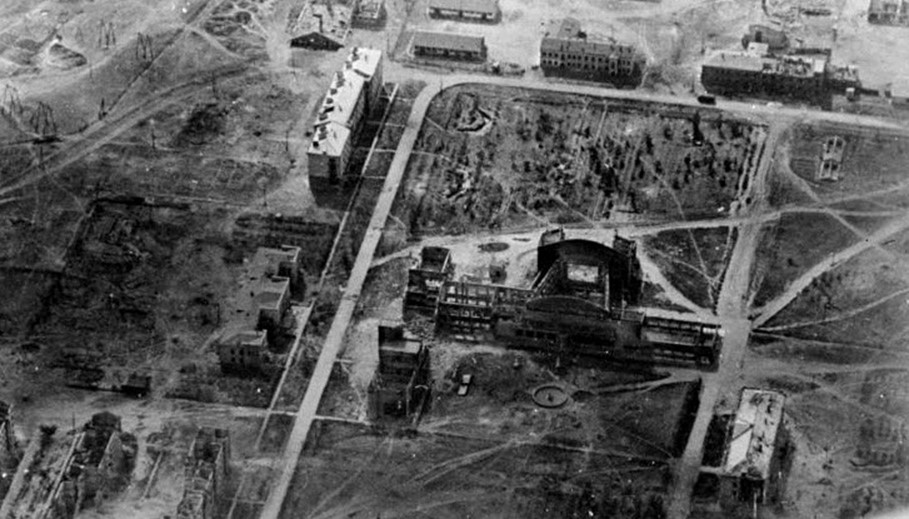A book review from Amazon regarding this high dollar tome on the T-34. Which breaks down the mythical aspects of the much vaunted T-34. An interesting quick read, written in 2009 by DarthRad.:
This book is another classic in the J.J. Federowicz line of specialty books – translations of outstanding non-English books of modern European military history, mainly World War II. As with many other J.J. Federowicz books, it has quickly gone out of print and the price of the few copies available have started to go up. Hopefully it will be brought back again for a wider audience.
In the history of World War II, the T-34 has indeed become a mythical weapon, and author Robert Michulec (Zientarzewski is listed as an author on the cover, but not in the overleaf or preface – Michulec credits him only as one of many contributors in the preface) makes clear from the start his intent to shred this myth with an extraordinarily detailed look at this Soviet tank.
From his Polish vantage point, Michulec had detailed access to the T-34 tanks and to the written histories from both Soviet and German sources, while maintaining a point of view free of the usual mythology. Michulec does go overboard at times in his efforts to downgrade the T-34 relative to its opponents, and there are a few minor inaccuracies. But the great strength of this book is the massive amount of detail, especially photographs of the T-34, which he uses to back up his point of view.

The book opens with its thesis that much of the myth of the T-34 was started largely by the post-WWII German biographies of Gen. Heinz Guderian and other German commanders and was later continued and magnified by Soviet era propaganda which censored all the negative aspects of the T-34. A long section is devoted to the Battle of Mcensk (more commonly spelled Mtsensk or Mzensk) in early October 1941, where the rapid advance of the German blitzkrieg was momentarily stopped, a success attributed by Guderian to T-34 tanks, but which Michulec states was really due to the German panzers outrunning their supplies, as the Germans had little trouble dispatching the T-34s in the battle. Michulec also shows how the Germans confused the more heavily armored KV-1 tank (which they did have trouble knocking out) with the more lightly armored T-34, thus conflating the two tanks together into a super tank that had greater capabilities than was possible in a single tank (a tank with the heavy armor of the KV-1 and the speed and mobility of the T-34 did not exist in 1941 – German efforts to develop such a tank would lead to the much-troubled, gas guzzling Panther tank).
The history and the politics behind the development of the T-34 tank is recounted in great detail, as is its complicated production history. The origin of the T-34 tank came from a requirement generated by Stalin and the Soviet Army in the mid-1930s to obtain an improved version of the Soviet BT series of tracked and wheeled tanks. In 1937, the main tank factory, Factory No. 183 in Kharkov, refused initially to produce what the army wanted. Continued arguments with the Army led to the replacement of Factory 183’s director and execution of its chief engineer. The initial prototypes were finally tested in 1939-1940, with production authorized on Jun 7, 1940 at Factory 183. An attempt to correct obvious design deficiencies in the early T-34 with the T-34M model was aborted by the German invasion.
The T-34 tank was not a single tank, but a series of tanks, and constantly changed throughout the war. The initial F-11 gun was replaced by the F-34 76.2 mm gun and later by the 85mm gun. A small number of T-34s with the 57mm high velocity Zis-2 anti-tank gun were produced. The 76.2mm T-34s had two main types of turrets – the initial “flat” turret (wielded and cast, p. 113) followed by the hexagonal turret with the blister-like front gun mounting (p. 123).
The tortuous decision process by which the T-34 tank was upgraded to the 85mm gun is also covered in detail. German improvements in tank firepower and armor forced an upgrade to the T-34. In April 1943, testing on a captured Tiger I tank showed that the existing 85mm Model 1939 anti-aircraft gun had promise. However, a series of modifications of this gun, the S-31, S-18, and D-5 all failed in further tests in August, 1943, as these guns would not work easily inside the original T-34 turrets. Additional tests with the D-5 and S-50 and S-53 guns were done in December 1943 and the S-53 gun was eventually selected, although a few T-34s were built with the D-5 gun. During this time, new turrets based on the abortive T-43 tank design which had the larger 1600mm turret ring were developed separately at Factories 183 and 112. The turrets from the two factories were always slightly different from one another as a result, and each turret also had multiple variants at each factory. The T-34/85 did not get additional hull armor, however, leaving the tank vulnerable to German anti-tank gunfire for the rest of the war.
The factories producing the T-34s also changed – the original two factories were Factory No. 183 in Kharkov, and the STZ factory in Stalingrad. The Kharkov factory was overtaken by the German advance, and only parts of its equipment and personnel were evacuated to the Urals at Nizhniy Tagil starting in late September 1941 – the new Factory 183 was almost a new factory. A third factory, No. 112 was started in Gorki during this same time. At the beginning of 1942, as Stalingrad became threatened, and the need for more tanks continued, the Soviets started three more factories, the UTZM in Ordzhonikidze, the CzTZ in Czelyabinsk, and the No.174 factory in Omsk. A chart on p. 220 shows the total production of the T-34 tanks at these various factories. The two Factory No. 183s had the largest output of tanks of all.

Some 58,681 T-34s were produced in all. Michulec estimates another 6,500 damaged T-34s were refurbished by these factories. Most telling of all is the statistic that some 45,000 T-34s were destroyed during the war. The T-34’s myth of superiority against the German Army was short lived. By late 1942, the Germans had installed the long barreled 75mm KwK 40 gun on their self propelled assault guns and their Pzkpfw IV tanks, which were more than capable of penetrating the frontal armor of the T-34. The Tiger and Panther tanks later on were even better at punching holes in the T-34. Finally, the Soviets continued their appalling tank tactics throughout WWII, mounting massed banzai charges with their tanks across open fields usually right into the waiting German anti-tank guns.
And so Michulec solidly drives home the point that contrary to the popular mythology of the T-34 as a nearly invincible tank, enormous numbers were knocked out by the Germans. The first half of the book is filled with photographs of knocked out T-34s to demonstrate this reality. Many of these photos show the T-34s to be completely shattered by internal explosions, with the hull coming apart as the result of shoddy welding, something never seen in photos of knocked out German or American tanks.
Michulec emphasizes the crude nature of Soviet manufacturing during WWII. The T-34 was not the solidly reliable machine of legend, being less reliable than both the U.S. M4 and the German Pzkpfw IV (the Panthers and Tigers were another story). Both its engine and transmission were highly prone to breakdowns, with T-34s often being sent off to the battle zones with a spare transmission tied to the engine deck. The many photographs of the very crude cast armor turrets produced during WWII underscore the quality control issues that made Soviet tank armor prone to spalling and thus far weaker than their rated thicknesses would indicate. Deficiencies in Soviet gun and ammunition manufacturing resulted in similar substandard results. The Soviet 76.2mm gun and 85mm gun had much weaker armor penetration characteristics than similar caliber weapons fielded by the Germans, British, and Americans.

The second half of this book goes into detail about the performance characteristics of the T-34/76 and the T-34/85 compared to German and British and American tanks. The two man turret of the T-34/76 had tremendous ergonomic problems – its lack of a dedicated tank commander and its lack of a radio in the turret meant that except at the very beginning of a battle, the tank crew of the T-34/76 usually fought blind and unguided, which severely limited the fighting qualities of the T-34/76. Other histories have told how German tank crews were often able to knock off one T-34 after another with the crews completely oblivious to the disaster going on around them. These problems were not fixed until the T-34/85.
Michulec goes overboard a bit, however, in some of his other comparisons – his table on p. 259 comparing the firepower of the M1 76mm gun of the Sherman tank and the British 17 pounder tank appears to use the HVAP round for the M1 gun, which was not widely available until late in WWII, as well as the APDS round of the 17 pounder which had problems with flight stability and accuracy. With regular armor piercing rounds, the Soviet 85mm, American 76mm, and the German KwK 40 were (according to other sources) all fairly similar in armor penetration, and the British 17 pounder was only slightly better than the German KwK 42. On the same page, the turret traverse for the Panther is stated to be 360 degrees in 15-18 seconds – this speed was true only if the driver was revving the engine to maximum speed while the gunner was turning the turret, a required coordinated process which did not always occur in the heat of battle.
A major section on the use of the T-34 in the Polish army follows, as well as details of its postwar deployment. The fact that Polish Army units with T-34s fought with the Soviets from October 1943 until the end of the war is a revelation. Western historical accounts of WWII have always only described the Polish soldiers and airmen who fought for the Western Allies. The book ends with an enormous number of photographs of every part of the T-34 and line drawings of the major variations of this tank.
“T-34 – Mythical Weapon” is a much needed antidote to the iron curtain of mystery that has long covered up the true history of the T-34 and contributed to its mythical status. It is clear that the author has a love-hate relationship with the T-34 – such loving detail as presented in this book and yet such an obvious distaste for its Soviet origins could only be explained by the Polish POV of its author.
It’s the L-11 gun not the F-11. And it’s the ZiS-4 and ZiS-4M, not the ZiS-2 (the ZiS-2 was the field artillery version, the tank version was 4)
This book was published by AirConnection Hobby Inc not J.J. Fedorowicz
If you review the book make sure you read it.
Well if you take the time to read the opening sentence you will see that this is a review from Amazon not me. So go post your whiny BS there.